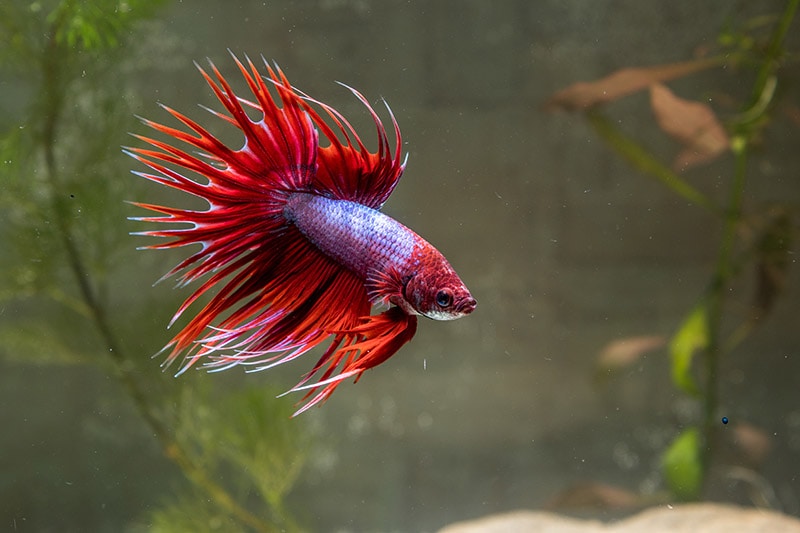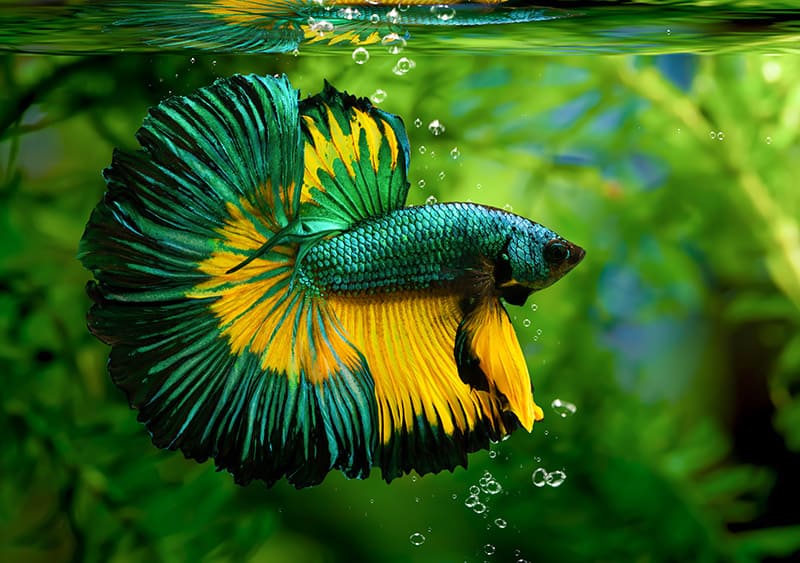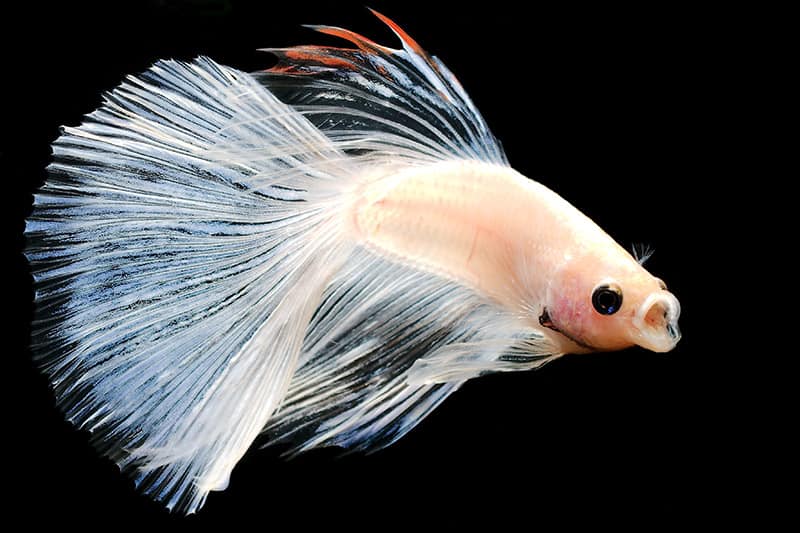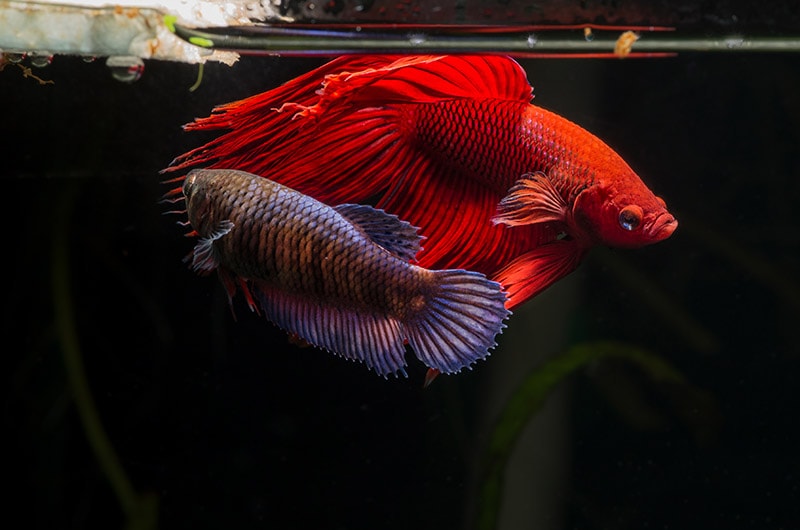Siamese Fighting Fish come in all the colors of the rainbow and are beautifully accented with graceful flowing fins!
Bettas Splendens are found in homes everywhere. They are kept by aquarists of all experience levels and only goldfish are more popular. Yet even though they aren’t found in as many forms as goldfish, their colors far surpass this competitor.
Male Bettas are the most dramatic. They are available in all sorts of gorgeous colorings and with several types of fins. Yet females can also be extremely striking. Males can be kept singly and females can be kept singly or as a group. They make a wonderful showpiece in a specimen tank, but can also be a very attractive addition to a peaceful community aquarium.
The coloring of Bettas is vast and you can basically get any color or combination of colors you want. Fin structure is the area that is more definitive, with five basic breed types. In general the males have the longest fins, but with some breed types they have short fins just like the females. This can cause confusion in sexing these Bettas, which is necessary if you want a male/female pair for breeding.
When selecting your Bettas you’ll want to choose a healthy fish. Then take look at the fin styles that are found on common Bettas as well on the show quality Bettas. To obtain the perfect pair for breeding, you also need to recognize the differences between the sexes.
Healthy Betta Fish
When selecting Bettas, you do want to make sure and get healthy specimens. Every fish you get should be well colored and full bodied. The gills should not move abnormally fast, it should be able to swim with ease, and it shouldn’t be grazing its sides on the bottom or on any decor. Make sure there aren’t any strange looking specks or cottony patches on its skin and the eyes should be clear.
Betta breeds: tail fin types
The traditional Betta is the original wild form of the Siamese Fighting Fish. This is a red and blue short-finned fish with a tail fin that is round or spade shaped. Now after years of selective breeding, there are 5 basic fin types:
Plakat Betta

The Plakat is a short-tailed Betta that is the most closely related to the wild Betta splendens. The wild fish are called ‘pla-kad’ by the natives, which literally means “biting fish”. It is the ancestor of all the Bettas we have developed today.
Because of its short fins, it is one of the types where the females and males can easily be confused. The male will display elongated ventral fins and a sharply pointed anal fin.
Many different betta breeds are described as having a “plakat body.” Basically there are three styles, or sub-categories, of plakat. The Traditional Plakat tail fin is rounded, or sometimes with a point giving it a spade-like look, and it has 2 rays. The Modern Halfmoon Plakat that has a 180 degree tail fin with 4 or more rays and elongated, slanted anal fin. The modern Halfmoon is the show type plakat and the anal fin is its defining characteristic. A third type is a Symmetrical Plakat that looks like the Modern Halfmoon, but has shorter fins.
Veil tail Betta

The Veil Tail (VT) is the most common breed of betta with long, drooping fins and a non-symmetrical tail. These are the Bettas that are readily available in pet stores and are mostly inexpensive.
The original fish of this group have not been exceptionally beautiful, but they are now being developed with longer and prettier fins. Newer versions have a tail fin that slopes gently and is held high, resembling a wedding veil.
Spade Tail Betta

Spade Tail Betta is a form that is not seen too often. Its tail fin has a wide base that narrows to a delicate point, looking like a spade.
Crowntail Betta

The male Crowntail Betta has longer fins that are spiky. When they extend the fin rays reach well beyond the outside margin of the membrane, giving the tail a crown-like appearance. The females also have these extended spiked margins, but their fins are much shorter.
Comb Tail Betta
These striking fish are very popular with both fanciers and hobbyist admirers. Comb Tail Betta is a less extended version of the Crown Tail.
Halfmoon Betta

The male Halfmoon Betta has the longest fin type. The fins are one continuous piece with edges that are crisp and straight.
When extended, the tail fin looks like a half-moon, forming a “D” shape at a 180 degree angle. The female also has long fins, but not nearly as long as the males.
Delta Tail Betta

The Delta Tail Betta is a variety of Halfmoon, but its tail fin is less than the 180 degree angle found on the Half-Moon, but it also has crisp and straight edges.
Bettas can also be a “double-tail” (DT) or a “split-tail,” which is where the tail fin is split in two.
These are not breed types, but rather are characteristics that can be found on any of the 5 basic fin types. A double tail (DT) is where the tail fin is split in two. If the fins are uneven, then it is not considered a true Double-tail Betta, but rather is called a Split-tail Betta.
Sexing Betta Fish
How to tell male or female betta fish? This is a problem you may encounter when you are making selections. For example, sometimes male Plakats are mistaken for females and sold as such in pet stores. So many people ask the question “What gender is my betta?” that a definitive answer is in order. Here are some of the differences between males and females:
Betta gill membrane
The biggest difference that will help you determine male or female is the presence of a gill membrane. When a male flares he will have a large extra membrane appear, forming a beard like presence around his whole chin. You can usually see his large gill membrane tucked in, even when he’s not flaring. Females do not have this membrane.Betta flares
Both male and female bettas flare. They will both flare at their own sex and at the opposite sex when they can see them through their container or tank. The fact that your betta flares is no guarantee that it is male, some females are just naturally very aggressive.
There are some subtle differences in the manner of flaring between male and female bettas though. Male bettas often (but not always) turn sideways onto an opponent and cross their ventral fins. Female bettas often, after a while, flare at male bettas in a submissive, head-down posture. They are unlikely to do this straight away, so patience is called for if you intend to use this as a component of sexing your betta.

Betta body Type
Looking at the rest of the body, there is another large difference between males and females, even in Plakats. The males almost always (90% of the time) have much longer and fuller ventral fins then the females do. Ovipositor
It is a common misconception that the presence of an ovipositor (the white speck between a fishes ventral fins) is evidence that it is a female. Unfortunately, life is not that simple. Numerous males display the ovipositor, so much so that in the IBC (International Betta Congress) shows it is a disqualifying characteristic in a male.
If your betta has an ovipositor it might be a female. But if it also has long fins it is probably a male. Even if it has short fins and an ovipositor it may be a Plakat male.
Bubblenesting
A common misconception is that only males build a bubble nest, but females build bubble nests too. In fact many have been witnessed to create a bubble nest, drop a load of eggs, place the eggs in the nest, and tend to them (before they are eventually eaten).
These are the main characteristics of the Betta fish to help you select and sex them. If you plan to attempt to breed them there are also a few other factors that you’ll also want to consider. Learn about the rest of the breeding process in the next two articles of this three part series, Breeding Bettas Part 2: Spawning Bettas in 5 Easy Steps and Breeding Bettas Part 3: Raising Betta Fry and Care.
Summary
All sorts of Siamese Fighting Fish varieties have been developed in each of the 5 basic fin types. See the Betta Splendens information page to learn all about these different types, as well as other Betta species that you may encounter.
Clarice Brough is a team member at Animal-World and has contributed many articles and write-ups.
Some excerpts are from BurningAmber520’s article “How To Sex Your Betta,” originally posted in Animals-World’s Aquatic Passions site.
Photos provided courtesy of Animal-World.com contributors on Dr. Jungle’s Pets and Animal Photos of Siamese Fighting Fish – Betta and Aquatic Passions contributors.
Featured Image Credit: Worachat Sodsri, Unsplash
